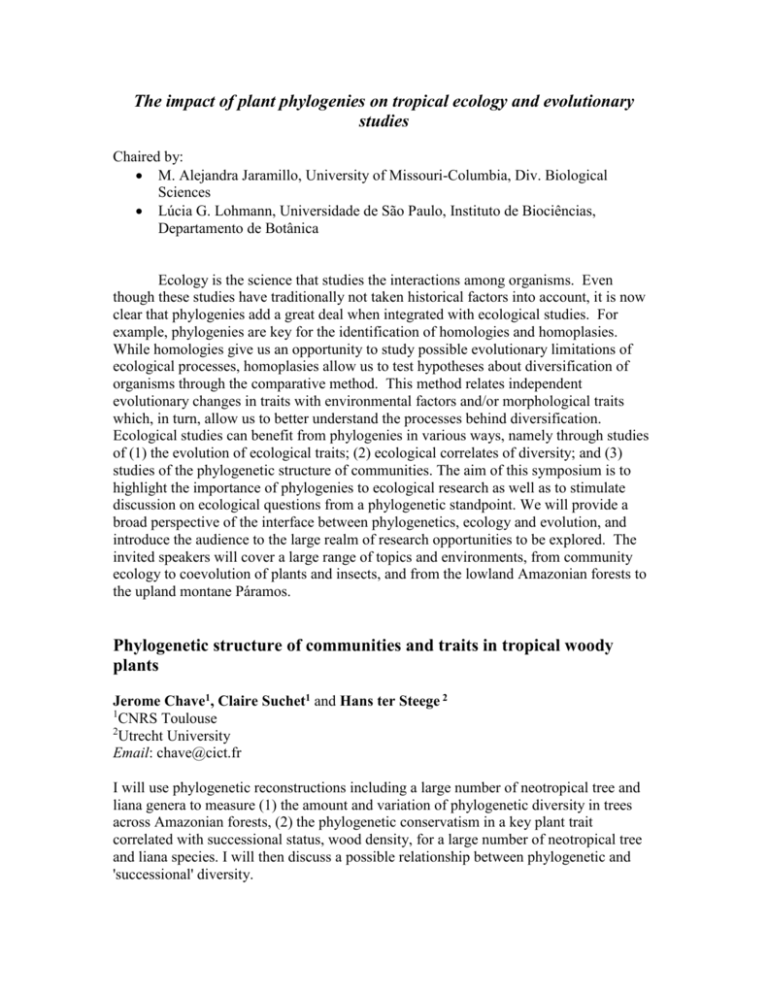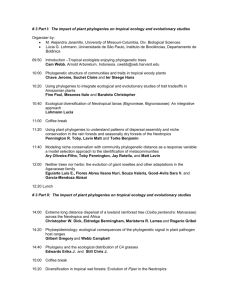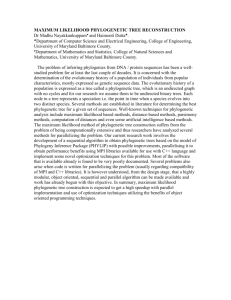The impact of plant phylogenies on tropical ecology and
advertisement

The impact of plant phylogenies on tropical ecology and evolutionary studies Chaired by: M. Alejandra Jaramillo, University of Missouri-Columbia, Div. Biological Sciences Lúcia G. Lohmann, Universidade de São Paulo, Instituto de Biociências, Departamento de Botânica Ecology is the science that studies the interactions among organisms. Even though these studies have traditionally not taken historical factors into account, it is now clear that phylogenies add a great deal when integrated with ecological studies. For example, phylogenies are key for the identification of homologies and homoplasies. While homologies give us an opportunity to study possible evolutionary limitations of ecological processes, homoplasies allow us to test hypotheses about diversification of organisms through the comparative method. This method relates independent evolutionary changes in traits with environmental factors and/or morphological traits which, in turn, allow us to better understand the processes behind diversification. Ecological studies can benefit from phylogenies in various ways, namely through studies of (1) the evolution of ecological traits; (2) ecological correlates of diversity; and (3) studies of the phylogenetic structure of communities. The aim of this symposium is to highlight the importance of phylogenies to ecological research as well as to stimulate discussion on ecological questions from a phylogenetic standpoint. We will provide a broad perspective of the interface between phylogenetics, ecology and evolution, and introduce the audience to the large realm of research opportunities to be explored. The invited speakers will cover a large range of topics and environments, from community ecology to coevolution of plants and insects, and from the lowland Amazonian forests to the upland montane Páramos. Phylogenetic structure of communities and traits in tropical woody plants Jerome Chave1, Claire Suchet1 and Hans ter Steege 2 1 CNRS Toulouse 2 Utrecht University Email: chave@cict.fr I will use phylogenetic reconstructions including a large number of neotropical tree and liana genera to measure (1) the amount and variation of phylogenetic diversity in trees across Amazonian forests, (2) the phylogenetic conservatism in a key plant trait correlated with successional status, wood density, for a large number of neotropical tree and liana species. I will then discuss a possible relationship between phylogenetic and 'successional' diversity. Keywords: phylogenetic diversity, wood density Using phylogenies to integrate ecological and evolutionary studies of trait tradeoffs in Amazonian plants Paul Fine1, Italo Mesones 2 and Christopher Baraloto 3 1 University of California, Berkeley 2 Universidad Nacional de la Amazonia Peruana 3 University of Florida Email: paulfine@berkeley.edu The phylogenetic structure of communities can provide insight into the processes controlling species distributions, including the evolution of traits that confer advantages in one habitat at the expense of a second habitat. Two different approaches have been used to evaluate the phylogenetic basis of these trait tradeoffs among different plant communities. One method correlates phylogenetic distances with species trait data and/or environmental data to test for patterns of evolutionary convergence in traits and/or environmental niche specialization. A second method ignores phylogenetic branch lengths. Instead, it contrasts multiple pairs of sister taxa that are habitat specialists, and conducts reciprocal transplant experiments to test for differential performance and phenotypic expression across habitats. We review the strengths and limitations of these two approaches using data for twenty species from the genus Protium (Burseraceae) that represent edaphic specialists from white-sand and clay terra firme forests in the Amazon basin. We examine evolutionary convergence and environmental filtering for traits related to growth, chemical and physical anti-herbivore defense and abiotic stress tolerance. We discuss ways to integrate phylogenetic distance data with observations and experiments to increase our understanding of trait tradeoffs and the mechanisms that underlie habitat specialization and speciation in Amazonian forests. Keywords: community assembly; habitat specialization, growth-defense trade-off Ecological diversification of Neotropical lianas (Bignonieae, Bignoniaceae): an integrative approach Lucia Lohmann Universidade de Sao Paulo Email: llohmann@usp.br Lianas account for a third of leaf biomasss of tropical forests, contribute between 20-25% of the floristic diversity of the neotropics, and have important roles in ecosystem level functioning. Yet they have been little studied, and little is known concerning their systematics, evolution, ecology and biogeography. The tribe Bignonieae (Bignoniaceae) constitutes the most diverse and abundant clade of lianas in the neotropics. Apart from being important components of neotropical forests, members of Bignonieae are also known for their showy flowers associated with different pollinators, unusual extra-floral nectaries associated with herbivore defense, and diverse dispersal mechanisms. It is well established that evolution has produced large amounts of variation in ecological traits in Bignonieae but relatively little is known about the processes that underlie this diversity. Comparative studies that integrate phylogenetics, divergence time estimates, and ecological data are helping to advance our knowledge in this area. Here I use a phylogenetic framework to test alternative hypotheses on the ecological diversification of this clade. Overall, key ecological traits have arisen several times during the diversification of the group and seem to reflect changes in the environment. Divergence time estimates suggest that the independent origins of ecological traits have occurred across a broad temporal scale, subsequently to changes in environmental conditions. This pattern is consistent with adaptation and suggests that a nested hierarchy of adaptations had a key role in the diversification of the group as a whole. Keywords: Bignonieae, Bignoniaceae, Comparative Method, Diversification, Adaptation Using plant phylogenies to understand patterns of dispersal assembly and niche conservation in the rain forests and seasonally dry forests of the Neotropics R. Toby Pennington1, Matt Lavin2 and Benjamin Torke3 1 Royal Botanic Garden Edinburgh 2 Plant Sciences and Plant Pathology, Montana State University, Bozeman 3 Academy of Natural Sciences, Philadelphia Email: t.pennington@rbge.org.uk Phylogenies of plant groups with species found in diverse biomes tend to indicate that speciation events between biomes ("biome switching") is infrequent. Phylogenies of plant genera largely endemic to neotropical rain forests such as Inga and Swartzia (Leguminosae) show different biogeographic patterns in comparison to genera largely restricted to neotropical seasonally dry forests such as Coursetia, Poissonia, Ateleia, Cyathostegia (Leguminosae) and Ruprechtia (Polygonaceae). In the rain forest genera, phylogenetic geographic structure is low, especially in Amazonia, meaning sympatric species in a single region are not closely related. In contrast, in a single area of dry forest, congeneric species tend to be closely related and often form monophyletic groups. These patterns imply greater historical dispersal limitation between smaller, isolated areas of dry forests than within and between larger rain forest areas, suggesting different patterns of community assembly. This hypothesis of different dispersal assembly within biomes may be testable using the framework of phylogenetic community structure, because more sympatric congeners might be expected to be found in rain forests than dry forests. Furthermore, it may also be manifest in different patterns of relative species abundance because rare species may more often drift to middling abundance in dry forests that are less perturbed by immigration. Keywords: Biogeography, community assembly, dispersal, ecological speciation, phylogenetic community structure Modeling niche conservation with community phylogenetic distance as a response variable: a model selection approach to the identification of metacommunities Ary Oliveira-Filho, Toby Pennington, Jay Rotella, and Matt Lavin Molecular phylogenetic analysis of tropical legumes suggests that patchily distributed seasonally dry tropical forests form a dispersal limited metacommunity with a potentially high diversity generating capacity. This is inferred from strong patterns of geographic phylogenetic structure of narrowly distributed clades, each of which may comprise multiple allopatric species. To test this hypothesis, we take a model selection approach. Explanatory variables include geographic distances, from which dispersal limitation can be inferred, and environmental distances (e.g., measures of moisture, altitude, etc.), from which niche assembly can be inferred. Phylogenetic distance as a response variable provides insights into the degree of niche conservation. In contrast, community distance (e.g., Sorensen) as a response provides insights into the relative contribution of dispersal versus niche assembly. A metacommunity may have dispersal limited local communities because of niche assembly. If speciation events are equally likely to encompass all of the local variation within a metacommunity, dispersal limitation will not be evident at the clade level. A simple example that illustrates this approach involves inventory data taken from deciduous and semidecidous forest in Brazil. Key Words: phylogenetic distance, biodiversity, dispersal limitation, niche assembly Neither trees nor herbs: the evolution of giant rosettes and other adaptations in the Agavaceae family Luis E. Eguiarte1, Ileana Nuri Flores Abreu1, Valeria Souza1, Sara V. Good-Avila2 and Abisai Garcia-Mendoza3 1 Instituto de Ecologia, Universidad Nacional Autonoma de Mexico (UNAM) 2 Acadia University, Canada 3 Instituto de Biologia, Universidad Nacional Autonoma de Mexico (UNAM) Email: fruns@servidor.unam.mx In the Agave L. family (Agavaceae, Endlicher) we recognize nine genera and ca. of 300 plant species, all native to the Americas. Most of the species and all the genera are found in Mexico. In particular here we analyze the genus Agave sensu lato, including Agave, Manfreda Salisb., Polianthes L. and Prochnyanthes Watson, representing at least 208 species that include key-stone species both because of its ecological dominance and the large amounts of resources produced by its massive, suicide flowering. Agave is also of huge economic value to Mexico because the plants are the raw material for the production of tequila and mezcal. We explore the adaptive radiation in the genus Agave sensu lato using recently obtained sequences of non-coding chloroplast regions (matKtrnK,trnL-trnF,trnD-trnT) for a set of 49 species of the family, using a Yucca-like fossil age and other new calibration dates. The main pollinator of Agave is the nectarivorous bat Leptonycteris curasoae and ecological observations suggest it has had a critical role in the evolution of the semelparous (suicide) reproduction in Agave. We analyze the hypothesis of a Leptonycteris-Agave coevolution using molecular clocks by dating the origin of both genera. We also evaluate if there is a correlation between the different reproductive strategies and the increase in speciation rate in the Agavaceae, as well as the evolution of Agave geographic ranges using statistical tests with a likelihood framework. Keywords: Agave, Leptonycteris, coevolution, molecular clock, speciation rate Extreme long distance dispersal of a lowland rainforest tree (Ceiba pentandra: Malvaceae) across the Neotropics and Africa Christopher W. Dick 1, 2, Eldredge Bermingham2, Maristerra R. Lemes3 and Rogerio Gribel3 1 Department of Ecology and Evolutionary Biology and Herbarium, University of Michigan 2 Smithsonian Tropical Research Institute 3 Instituto Nacional de Pesquisas da Amazônia (INPA), Laboratorio de Genetica e Biologia Reprodutiva de Plantas Many tropical tree species occupy continental expanses of rainforest and flank dispersal barriers such as oceans and mountains. Phylogenetic techniques can be used to infer the geographic origins of such species and test whether their broad geographic distributions arise from vicariance or long distance dispersal (LDD). This talk focuses on the biogeographic history of the kapok tree, Ceiba pentandra (Malvaceae), which is naturally widespread across equatorial Africa and the Neotropics. Phylogeography and molecular clock methods are used to show that Ceiba pentandra originated in the Neotropics and dispersed via wind or marine currents to equatorial Africa. Within the Neotropics C. pentandra spread to Caribbean islands and across the Northern Andes by long distance dispersal. In Africa, Ceiba pentandra experienced pronounced ecological divergence in savannah habitat. Ceiba pentandra is one of many rainforest tree taxa that display the amphiatlantic distribution. The study illustrates how long distance dispersal, via wind or marine currents, produces taxonomic similarities in the rainforests of Africa and the Neotropics. Phyloepidemiology: ecological consequences of the phylogenetic signal in plant pathogen host ranges Gilbert Gregory1 and Campbell Webb 2 1 University of California, Santa Cruz 2 The Arnold Arboretum, Harvard University Email: ggilbert@ucsc.edu Most plant pathogens are polyphagous, but each fungal pathogen can attack only a subset of plant species in a diverse local community. Cross-inoculations with necrotrophic foliar pathogens from rainforest plant species showed a broad spectrum of host ranges, with a median of 27% of species susceptible. Species and genus specialists are rare; instead, there was a strong, continuous phylogenetic signal in the host range. When tested on congeneric hosts, two-thirds of pathogens caused disease on both hosts, with the likelihood that two plant species would share a particular pathogen declining continuously to 30%, when plant pairs were separated by 233 My of independent evolution. If plant pathogens are important in maintaining diversity in tropical forests as has often been suggested, local host selectivity is essential. The observed phylogenetic signal in host ranges suggests that pathogens may be more important in maintaining diversity at higher phylogenetic levels. At the same time, the phylogenetic diversity of a plant community may determine the apparent degree of specialization within the associated fungal community. In diverse tropical forests where phylogenetic distances among plant species vary continuously from very close to very distant relatives, the polypore fungal community is dominated by non-specialists. In contrast, in species-poor mangrove forests where phylogenetic distances among tree species are generally large, the fungal community is dominated by host specialists.Understanding the phylogenetic structure of pathogen host range provides a new tool for the study of the evolutionary ecology of plant diseases in tropical ecosystems. Keywords: fungal diversity, disease ecology, Panama, host specificity, phylogenetic ecology Phylogeny and the ecological distribution of C4 grasses Erika J. Edwards1 and Chris J. Still2 1 Brown University 2 University of California at Santa Barbara Email: eedwards@icess.ucsb.edu C4 photosynthesis refers to a suite of biochemical and anatomical traits that reduce photorespiration in plants and promote photosynthetic efficiency in high light, high temperature environments. While the C4 pathway has evolved in numerous angiosperm lineages, it is most common in the grasses. Globally, C4 grasses are dominant members of tropical grassland/savanna communities and are conspicuously absent from cooler climates. There are well-understood physiological mechanisms that have been invoked to explain this pattern; however, C4 photosynthesis evolved exclusively in grass lineages of tropical origin, so an alternative and untested hypothesis is that C4 grasses were preadapted to warm climates and that photosynthetic pathway variation is not the primary driver of perceived C3/C4 sorting along temperature gradients. We tease this problem apart by analyzing the climate niches of 156 species of the Hawaiian grass flora within a phylogenetic framework. Using climate data from location points for over 3500 georeferenced herbarium specimens and current knowledge of evolutionary relationships within Poaceae, we find strong phylogenetic conservatism for all climate parameters. Most cool climate grasses belong to the BEP grass clade, while most warm climate grasses belong to the PACCAD clade, which contains a mix of both C3 and C4 species. Within the PACCAD clade, shifts to C4 photosynthesis are more tightly correlated with lower precipitation than with higher temperatures. Additionally, divergences in temperature profiles between C4 sister taxa are significantly smaller than those between C3 sister taxa or C3/C4 splits. These results suggest that the relationship between C4 grass distribution and climate is complex, and that the broad global patterns correlating C4 abundance with high temperatures may be mostly due to historical effects. Furthermore, C4 photosynthesis may in part be limiting ecological diversification by restricting the realized temperature ranges of C4 species. Keywords: C4 grasses, ecological sorting, Hawaiian Islands, phylogeny, niche evolution Diversification in tropical wet forests: evolution of Piper in the Neotropics M. Alejandra Jaramillo University of Missouri-Columbia Email: jaramilloa@missouri.edu Piper, with > 1000 species, is one of the 10 largest genera of flowering plants. Piper plants thrive in wet tropical forests where they are a dominant element of the forest understory. Piper offers an excellent opportunity to test hypothesis about diversification in the wet tropics and the importance of geography in this process. Analyses of the species geographic distribution in the Neotropics suggest that the Piper flora can be divided into four major biogeographic components: Central America, the Andes, the Amazon and the Atlantic Forest (AF) of Brasil. There are a few species that occur throughout the Neotropics, nevertheless most species are restricted to one of the subregions or, even, portions of them: Central AF, the Choco Region (ChR), or the Antilles. We use a comparative method based on a robust phylogenetic framework to test hypothesis of geographic diversification of the genus in the Neotropics. Keywords: wet forests, phylogen The origin and radiation of the Andean Espeletiinae: do chloroplast and nuclear gene phylogenies disagree? Jason Rauscher University of Puerto Rico, Rio Piedras Email: rauscher@evoandes.net The subtribe Espeletiinae (Asteraceae: Millerieae) includes more than 130 species and 8 genera endemic to the tropical montane paramos of northwest South America. Despite its recent (<3-5 my) origin, this group exhibits extraordinary diversity of morphology, life form and ecology. Morphological divergence has made an understanding of its phylogeny elusive, but recent molecular studies have provided insights, such as the identification of Ichthyothere as its closest living relative. Phylogeny at the species level has proved more challenging due to low genetic variation. Nuclear ribosomal DNA-ITS data has led to new hypotheses of the evolution and biogeography of the group by identifying clades that are congruent with both morphology and geography of the Andes. Preliminary sequencing of >20 chloroplast regions has also revealed low levels of variation. However, sequencing of 8 of the most variable of these regions for a sample of 30 species is beginning to elucidate the chloroplast phylogeny for the Espeletiinae. The results point to significant topological conflicts between the chloroplast and ITS phylogenies, particularly in the rooting of the tree, which has important implications for the origin and early evolution of this radiation. While lineage sorting or homoplasy may explain intergenic conflict, species interfertility and the apparent frequency of hybridization could also explain this pattern, through the genetic effects of diploid hybrid speciation and/or introgression. A study of chloroplast and ITS diversity across a hybrid zone between two Venezuelan species reveals complex patterns of genetic diversity and introgression that may support the hypothesis that hybridization is the source of the ITS/chloroplast conflict. Ultimately, understanding the evolution of rapidly evolving groups such as the Espeletiinae will require careful interpretation of multiple gene phylogenies as well as detailed studies of the morphology, ecology, ecophysiology and palynology of these species. Keywords: andes, paramo, espeletiinae, phylogeny, hybridization The evolutionary history of the fig-fig wasp mutualism Carlos A. Machado Dept. Ecology and Evolutionary Biology University of Arizona Tucson Email: cmachado@email.arizona.edu I will provide an overview of our current knowledge on the evolutionary history of the fig/fig wasp mutualism. I will focus on recent work in my lab that is addressing the consequences that the presence of multiple pollinators per fig species has had on patterns of divergence in figs, using an example from a Neotropical group of species from section Urostigma Americana.






